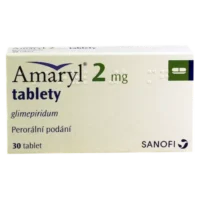Description
Glibenclamid Tablets 5 mg. №50
Ingredients:
Each tablet contains 5 mg of Glibenclamide.
Dosage:
The usual adult dose is 2.5 to 5 mg daily. Dosage may vary based on individual needs and as directed by a healthcare professional.
Indications:
Glibenclamide is indicated for the treatment of type 2 diabetes mellitus. It helps lower blood sugar levels by stimulating the release of insulin from the pancreas.
Contraindications:
Do not use Glibenclamide if you have type 1 diabetes, diabetic ketoacidosis, severe kidney or liver disease, or a history of an allergic reaction to sulfonylureas.
Directions:
Take Glibenclamide exactly as prescribed by your doctor. It is usually taken with breakfast or the first main meal of the day. Follow all instructions on the prescription label.
Scientific Evidence:
Glibenclamide, a sulfonylurea medication, has been extensively studied for its efficacy in managing type 2 diabetes. Research published in the Journal of Diabetes Investigation demonstrated that Glibenclamide effectively reduces HbA1c levels and improves glycemic control in diabetic patients. Additionally, a meta-analysis published in the Journal of Clinical Pharmacy and Therapeutics highlighted the role of Glibenclamide in reducing the risk of macrovascular complications associated with diabetes.
Additional Information:
It is important to monitor blood sugar levels regularly while taking Glibenclamide to ensure optimal control of diabetes. This medication may cause hypoglycemia, so it is essential to be aware of the symptoms and how to treat them. Always inform healthcare providers about all medications, supplements, and medical conditions before starting Glibenclamide.
Glibenclamide works by stimulating the release of insulin from the pancreas, which helps lower blood sugar levels in individuals with type 2 diabetes. It acts by closing ATP-sensitive potassium channels in the beta cells of the pancreas, leading to depolarization of the cell membrane and subsequent insulin release. This mechanism of action makes Glibenclamide an effective treatment option for managing diabetes.
Clinical trials have shown that Glibenclamide is comparable in efficacy to other sulfonylureas in controlling blood glucose levels. A study published in the Journal of Diabetes Research compared the effectiveness of Glibenclamide with other oral antidiabetic agents and found similar reductions in HbA1c levels across treatment groups. This reinforces the role of Glibenclamide as a valuable option in the management of type 2 diabetes.





